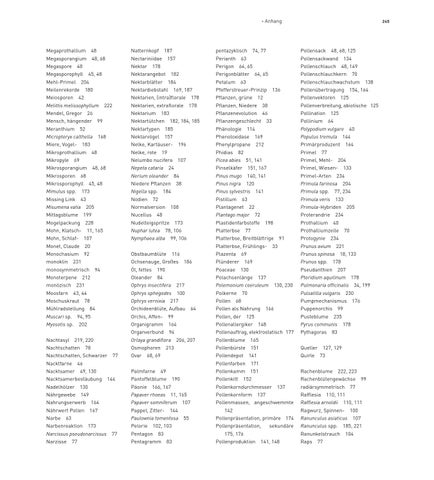• Anhang
Megaprothallium 48 Megasporangium 48, 68 Megaspore 48 Megasporophyll 45, 48 Mehl-Primel 204 Meilenrekorde 180 Meiosporen 42 Melittis melissophyllum 222 Mendel, Gregor 26 Mensch, hängender 99 Meranthium 52 Micropteryx calthella 168 Miere, Vogel- 183 Mikroprothallium 48 Mikropyle 69 Mikrosporangium 48, 68 Mikrosporen 68 Mikrosporophyll 45, 48 Mimulus spp. 173 Missing Link 43 Misumena vatia 205 Mittagsblume 199 Mogelpackung 228 Mohn, Klatsch- 11, 165 Mohn, Schlaf- 107 Monet, Claude 20 Monochasium 92 monoklin 231 monosymmetrisch 94 Monoterpene 212 monözisch 231 Moosfarn 43, 44 Moschuskraut 78 Mühlradstellung 84 Muscari sp. 94, 95 Myosotis sp. 202 Nachtasyl 219, 220 Nachtschatten 78 Nachtschatten, Schwarzer 77 Nacktfarne 46 Nacktsamer 49, 130 Nacktsamerbestäubung 144 Nadelhölzer 130 Nährgewebe 149 Nahrungserwerb 164 Nährwert Pollen 167 Narbe 63 Narbenreaktion 173 Narcissus pseudonarcissus 77 Narzisse 77
IN_Kremer_Blueten_def.indd 245
Natternkopf 187 Nectariniidae 157 Nektar 178 Nektarangebot 182 Nektarblätter 184 Nektardiebstahl 169, 187 Nektarien, (intra)florale 178 Nektarien, extraflorale 178 Nektarium 183 Nektartütchen 182, 184, 185 Nektartypen 185 Nektarvögel 157 Nelke, Kartäuser- 196 Nelke, rote 19 Nelumbo nucifera 107 Nepeta cataria 24 Nerium oleander 84 Niedere Pflanzen 38 Nigella spp. 184 Nodien 72 Normalversion 108 Nucellus 48 Nudelteigspritze 173 Nuphar lutea 78, 106 Nymphaea alba 99, 106 Obstbaumblüte 116 Ochsenauge, Großes 186 Öl, fettes 190 Oleander 84 Ophrys insectifera 217 Ophrys sphegodes 100 Ophrys vernixia 217 Orchideenblüte, Aufbau 64 Orchis, Affen- 99 Organigramm 164 Organverbund 94 Orlaya grandiflora 206, 207 Osmophoren 213 Ovar 68, 69 Palmfarne 49 Pantoffelblume 190 Päonie 166, 167 Papaver rhoeas 11, 165 Papaver somniferum 107 Pappel, Zitter- 144 Paulownia tomentosa 55 Pelorie 102, 103 Pentagon 83 Pentagramm 83
245
pentazyklisch 74, 77 Perianth 63 Perigon 64, 65 Perigonblätter 64, 65 Petalum 63 Pfefferstreuer-Prinzip 136 Pflanzen, grüne 12 Pflanzen, Niedere 38 Pflanzenevolution 46 Pflanzengeschlecht 33 Phänologie 114 Phenoloxidase 169 Phenylpropane 212 Phidias 82 Picea abies 51, 141
Pollensack 48, 68, 125 Pollensackwand 134 Pollenschlauch 48, 149 Pollenschlauchkern 70 Pollenschlauchwachstum 138 Pollenübertragung 154, 164 Pollenvektoren 125 Pollenverbreitung, abiotische 125 Pollination 125 Pollinium 64 Polypodium vulgare 40 Populus tremula 144 Primärproduzent 164 Primel 77 Primel, Mehl- 204
Pinselkäfer 151, 167 Pinus mugo 140, 141 Pinus nigra 120 Pinus sylvestris 141 Pistillum 63 Plantagenet 22 Plantago major 72 Plastidenfarbstoffe 198 Platterbse 77 Platterbse, Breitblättrige 91 Platterbse, Frühlings- 33
Primel, Wiesen- 133 Primel-Arten 234 Primula farinosa 204 Primula spp. 77, 234 Primula veris 133 Primula-Hybriden 205 Proterandrie 234 Prothallium 40 Prothalliumzelle 70 Protogynie 234 Prunus avium 221 Prunus spinosa 18, 133 Prunus spp. 178 Pseudanthien 207 Pteridium aquilinum 178 Pulmonaria officinalis 34, 199 Pulsatilla vulgaris 230 Pumpmechanismus 176 Puppenorchis 99 Pusteblume 235 Pyrus communis 178 Pythagoras 83
Plazenta 69 Plünderer 169 Poaceae 130 Polachsenlänge 137 Polemonium coeruleum 130, 230 Polkerne 70 Pollen 68 Pollen als Nahrung 166 Pollen, der 125 Pollenallergiker 148 Pollenauftrag, elektrostatisch 177 Pollenblume 165 Pollenbürste 151 Pollendepot 141 Pollenfarben 171 Pollenkamm 151 Pollenkitt 152 Pollenkorndurchmesser 137 Pollenkornform 137 Pollenmassen, angeschwemmte 142 Pollenpräsentation, primäre 174 Pollenpräsentation, sekundäre 175, 176 Pollenproduktion 141, 148
Queller 127, 129 Quirle 73 Rachenblume 222, 223 Rachenblütengewächse 99 radiärsymmetrisch 77 Rafflesia 110, 111 Rafflesia arnoldii 110, 111 Ragwurz, Spinnen- 100 Ranunculus asiaticus 107 Ranunculus spp. 185, 221 Ranunkelstrauch 104 Raps 77
17.04.13 10:25
